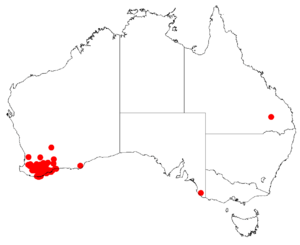Isopogon buxifolius facts for kids
Quick facts for kids Isopogon buxifolius |
|
|---|---|
 |
|
| Subspecies obovatus in the ANBG | |
| Scientific classification | |
| Genus: |
Isopogon
|
| Species: |
buxifolius
|
 |
|
| Occurrence data from Australasian Virtual Herbarium | |
| Synonyms | |
|
|
Isopogon buxifolius is a special kind of plant. It's a shrub that grows upright. You can find it only in the southwest part of Western Australia. This plant has leaves that look like eggs or are long and narrow. It also has pretty pink flowers that grow in groups. It belongs to the Proteaceae family, which has many unique Australian plants.
What Does It Look Like?
Isopogon buxifolius is a shrub that stands tall. It usually grows to be about 0.3 to 1.7 meters (about 1 to 5.5 feet) high. Its small branches are often reddish or brownish and can be a bit hairy.
The leaves of this plant can be different shapes. Some are shaped like an egg, others are long and narrow (oblong), or oval. They are usually 8 to 35 millimeters long. Each leaf has a tiny point at its tip.
The flowers are pink and grow in tight groups. These groups are called spikes. Each spike can be up to 20 millimeters long. The flowers are mostly smooth and are surrounded by leaves. This plant flowers from June to December. After flowering, it produces oval, hairy nuts. These nuts are joined together in a cup-shaped head, about 10 millimeters long.
How It Was Named
The plant Isopogon buxifolius was first officially described in 1810. A famous botanist named Robert Brown gave it its name. He wrote about it in a scientific paper called Transactions of the Linnean Society of London.
Later, in 1870, another botanist named George Bentham looked at this plant more closely. He described different types, or "varieties," of Isopogon buxifolius. Two of these varieties are still recognized today:
- Isopogon buxifolius var. buxifolius: This type usually has egg-shaped leaves that are 10 to 15 millimeters long. It mostly flowers from July to December.
- Isopogon buxifolius var. obovatus: This type has leaves that are oblong or egg-shaped, but narrower at the base. These leaves are longer, from 15 to 35 millimeters long and 7 to 14 millimeters wide. It usually flowers from June to October.
Some other types that Bentham described are now considered to be the same as a different plant, I. spathulatus.
Where It Grows
You can find Isopogon buxifolius in different parts of Western Australia.
- The variety buxifolius likes to grow in wet, swampy areas. It can be found between towns like Collie, Denmark, and Albany.
- The variety obovatus grows in sandy soil mixed with a type of rock called laterite. This type is found in a smaller area. This area is between the Stirling Range, Cape Riche, and Bremer Bay.
Protecting the Plant
The Government of Western Australia's Department of Parks and Wildlife keeps track of how rare or common plants are. They have given Isopogon buxifolius different conservation statuses:
- The variety buxifolius is listed as "Priority Two". This means it's not very well known and has only been found in a few places.
- The variety obovatus is listed as "Priority Three". This also means it's not well known and found in only a few spots. However, it's not thought to be in immediate danger right now.

